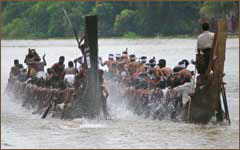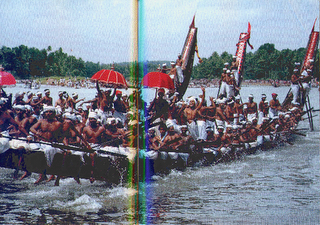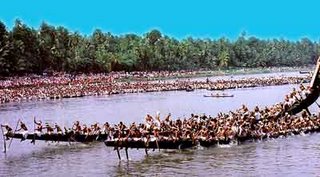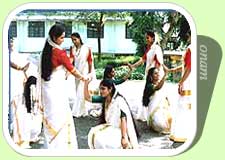
Atham - Day One
Atham is the first day of festivities in the ten-day-long Onam carnival. The day of Atham comes ten days before the asterism Onam or Thiru Onam hence Atham is regarded holy and auspicious by the traditional people of Kerala.
To complete the rituals of Atham people take early bath and offer prayers in the local temple. There is also a set breakfast for Atham consisting of steamed bananas and fried pappadam (pappad). This breakfast remains the same till the tenth and the last day of Thiru Onam. A swing decked with flowers is also slung from a high branch and youngsters take great delight in swinging and singing Oonjal (swing) songs.
Major highlight of Atham is that people start making pookalam from this day. Pookalam, also called Athapoo, is an intricate floral mat laid in the front courtyard by maidens of the house. This is done to welcome the holy spirit of legendary King Mahabali whose spirit is said to visit Kerala at the time of Onam. In subsequent days more flowers and new designs are added to this pookalam. Selection of flower is also an important matter as a particular flower is selected for each day for a specific deity. Great deal of thought and creativity is employed in the making of Pookalam as girls vie with each other for the best design.
Athachamyam
A grand procession called is also carriedAthachamyam
on the day of Atham to mark the beginning of the grand carnival of Onam. The procession is carried out to commemorate the royal custom of the erstwhile state of Kochi when it was customary for the King to travel with his entire entourage to the Thripunithura Fort. Even in the absence of King today, the custom still retains its majestic charm. Elephant processions, folk art presentations, music and dancing make Athachamyam a spectacular event. The procession of Athachamyam is of marked importance at Thripunithura, Kochi.
From the day of Atham an atmosphere of joy and jubilations envelops the very air of Kerala as people get engaged in one activity or the other. Everybody wishes to celebrate Onam in best possible manner.








 Thumbi Thullal is a fascinating all women dance and singing event performed in Kerala on the occasion of Onam. While men engage themselves in energetic sports, womenfolk perform Thumbi Thullal and have their share of fun.
Thumbi Thullal is a fascinating all women dance and singing event performed in Kerala on the occasion of Onam. While men engage themselves in energetic sports, womenfolk perform Thumbi Thullal and have their share of fun.